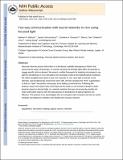| dc.contributor.author | Schummers, James | |
| dc.contributor.author | Deng, Yuting | |
| dc.contributor.author | Sur, Mriganka | |
| dc.contributor.author | Wilson, Nathan R. | |
| dc.contributor.author | Runyan, Caroline A. | |
| dc.contributor.author | Yan, Sherry X. | |
| dc.contributor.author | Chen, Robert E. | |
| dc.date.accessioned | 2015-01-12T20:21:14Z | |
| dc.date.available | 2015-01-12T20:21:14Z | |
| dc.date.issued | 2013-05 | |
| dc.identifier.issn | 1754-2189 | |
| dc.identifier.issn | 1750-2799 | |
| dc.identifier.uri | http://hdl.handle.net/1721.1/92804 | |
| dc.description.abstract | Neuronal networks process information in a distributed, spatially heterogeneous manner that transcends the layout of electrodes. In contrast, directed and steerable light offers the potential to engage specific cells on demand. We present a unified framework for adapting microscopes to use light for simultaneous in vivo stimulation and recording of cells at fine spatiotemporal resolutions. We use straightforward optics to lock onto networks in vivo, to steer light to activate circuit elements and to simultaneously record from other cells. We then actualize this 'free' augmentation on both an 'open' two-photon microscope and a leading commercial one. By following this protocol, setup of the system takes a few days, and the result is a noninvasive interface to brain dynamics based on directed light, at a network resolution that was not previously possible and which will further improve with the rapid advance in development of optical reporters and effectors. This protocol is for physiologists who are competent with computers and wish to extend hardware and software to interface more fluidly with neuronal networks. | en_US |
| dc.description.sponsorship | National Institutes of Health (U.S.) (Postdoctoral Fellowship) | en_US |
| dc.description.sponsorship | Simons Foundation (Postdoctoral Fellowship) | en_US |
| dc.description.sponsorship | National Institutes of Health (U.S.) (Predoctoral Fellowship) | en_US |
| dc.description.sponsorship | National Institutes of Health (U.S.) | en_US |
| dc.description.sponsorship | Simons Foundation | en_US |
| dc.language.iso | en_US | |
| dc.publisher | Nature Publishing Group | en_US |
| dc.relation.isversionof | http://dx.doi.org/10.1038/nprot.2013.063 | en_US |
| dc.rights | Creative Commons Attribution-Noncommercial-Share Alike | en_US |
| dc.rights.uri | http://creativecommons.org/licenses/by-nc-sa/4.0/ | en_US |
| dc.source | PMC | en_US |
| dc.title | Two-way communication with neural networks in vivo using focused light | en_US |
| dc.type | Article | en_US |
| dc.identifier.citation | Wilson, Nathan R, James Schummers, Caroline A Runyan, Sherry X Yan, Robert E Chen, Yuting Deng, and Mriganka Sur. “Two-Way Communication with Neural Networks in Vivo Using Focused Light.” Nat Protoc 8, no. 6 (May 23, 2013): 1184–1203. | en_US |
| dc.contributor.department | Massachusetts Institute of Technology. Department of Brain and Cognitive Sciences | en_US |
| dc.contributor.department | Picower Institute for Learning and Memory | en_US |
| dc.contributor.mitauthor | Wilson, Nathan R. | en_US |
| dc.contributor.mitauthor | Runyan, Caroline A. | en_US |
| dc.contributor.mitauthor | Yan, Sherry X. | en_US |
| dc.contributor.mitauthor | Chen, Robert E. | en_US |
| dc.contributor.mitauthor | Deng, Yuting | en_US |
| dc.contributor.mitauthor | Sur, Mriganka | en_US |
| dc.relation.journal | Nature Protocols | en_US |
| dc.eprint.version | Author's final manuscript | en_US |
| dc.type.uri | http://purl.org/eprint/type/JournalArticle | en_US |
| eprint.status | http://purl.org/eprint/status/PeerReviewed | en_US |
| dspace.orderedauthors | Wilson, Nathan R; Schummers, James; Runyan, Caroline A; Yan, Sherry X; Chen, Robert E; Deng, Yuting; Sur, Mriganka | en_US |
| dc.identifier.orcid | https://orcid.org/0000-0003-2442-5671 | |
| mit.license | OPEN_ACCESS_POLICY | en_US |
| mit.metadata.status | Complete | |
